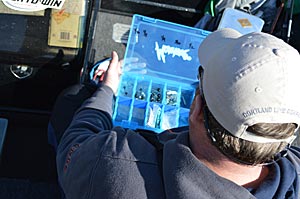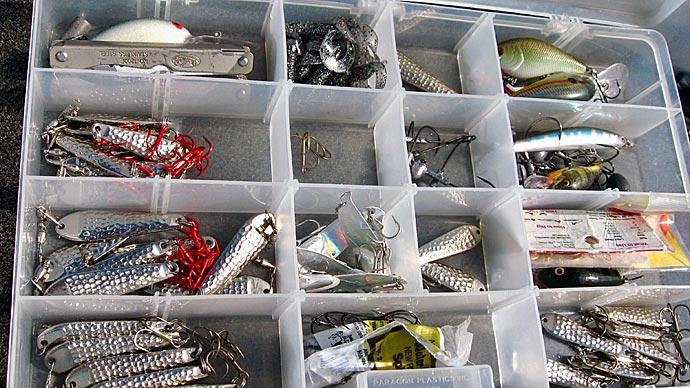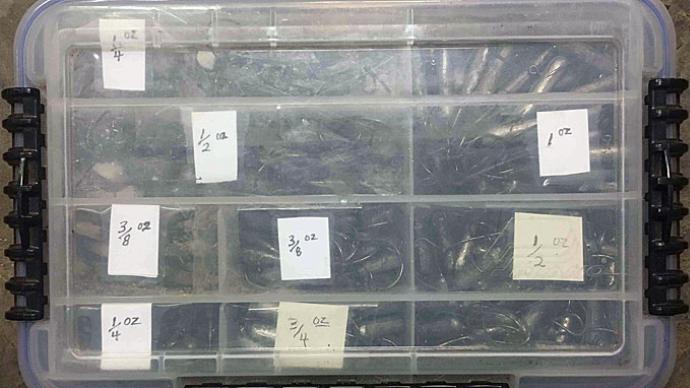
All bass anglers can relate to this scenario. You’re on a hot bite, landing a couple of big bass in only a few casts. Then you break off the lure or shred the soft-plastic bait that worked so well. You dive into a boat compartment or tackle bag for another one. It’s not in this tackle box or that one. You open a third, but that’s filled with lures you probably won’t use this day. You search yet another. Seconds become minutes. You know you have one. Then you find it stuck in a box with a different type of lure. But by now, your boat has drifted from the spot, or the bass have stopped biting.
You can’t catch bass if your lure isn’t in the water, and searching for tackle is one of the best ways to keep that from happening. Time is money, as they say, and that’s even truer for professional anglers. Erie, Pa.-based pro Dave Lefebre knows a little something about that. For 13 years, he was an FLW Tour pro, amassing more than $1.8 million in earnings. This year he’ll fish the Bassmaster Elite Series. Preparation is a big part of being successful on either trail. Before he heads to his first Elite Series event on Florida’s St. John’s River, he’ll spend two weeks — all day each day, like he was punching the clock at a regular job — organizing and packing his tackle.
Lefebre has fished full-time since 2003. “The longer you do this, the more [tackle] you compile, and it can get out of control,” he said. He has refined a process for managing and organizing his mountain of tackle. While you might never acquire as much as him, you can learn from his system because the easier it’s for you to find a lure, the more bass you’ll catch.
Bring only what you need.
Lefebre’s 2016 tournament season will take him to unfamiliar territory. While he’s fished many, if not all, the waters, he’ll have to adjust his fishing style. One of the most significant changes will be not having a co-angler fishing from the back deck of his boat. The FLW Tour recently reduced co-angler participation from three to two days at each event. They haven’t fished in the Elite Series since the 2008 season.
FLW Tour pros have to consider their co-anglers. They need to make storage available and run the boat in a way that doesn’t stifle their fishing opportunities. Lefebre said pros also have to pay attention to how co-anglers catch bass. If they started catching on a shakey head, for example, he’d pick one up, too, to ensure he caught his share from the spot. Without a co-angler, he can stick to throwing big-bass lures, regardless of how slow the bite, and leave the shakey heads at home.
“It’s all about funneling down the choices and gear to exactly what you do,” Lefebre said. “That makes for better decisions. Just like you wouldn’t need topwaters in January unless you are fishing warm-water discharges for schoolies or in Florida, you don’t need to pack that stuff. “The more you have in the boat, the more you have in the back of your head,” he said.
Simply put, access to too much tackle can be a distraction.
You know the lures that you fish each season. In early spring, for example, you’ll want your jigs, crankbaits, spinnerbaits, and jerkbaits. But you probably won’t be throwing an umbrella rig, hollow-bodied frogs, or 10-inch plastic worms. Those decisions also can be based on the species of bass you’re chasing and the type of water you’ll fish. Using a modular system of utility boxes, such as Plano 3600s or 3700s, you can pull those holding the lures you’ll need for each trip and leave the rest home.
If you are fishing several days in a row, you can whittle tackle as you go. Lefebre has eliminated much of the tackle he starts practice with by the time the tournament starts. What isn’t working goes into his truck. What is working may take up just a couple of utility boxes.
Take the 2015 FLW Tour stop at Alabama’s Lewis Smith Lake. “I had one box filled with Fish Head Spins with soft trailers,” he said. The night before, he would glue them together, so he had about ten ready to go. Those, along with a Rapala wake bait, caught most of the 65 pounds and 5 ounces he landed for the win.
Know what you have

Lefebre likened organizing tackle to storing digital photos. As time goes on, you take more and have to find ways to store them, whether on CDs, the cloud, or thumb drives. You must keep the old tackle — some of the lures he uses are decades old — and experiment with new ones. “You’re stupid not to try [them],” he said. And then you must find each, along with the tackle you use day in and out when you need it.
Lefebre designed his new home around its garage, where he stores his tackle, boat, and other fishing gear. When he pulls in his boat, boxes and bins of tackle are stacked to the right while more hang on the pegboard to the left. After he returns from a tournament, he removes all the tackle from his boat and truck and returns it to its designated spots in the garage. Then he starts over, pulling what he’ll need for the next one.
Whether you store your tackle in a garage, basement, spare room, or shed, it needs to be organized similarly to the tackle that’s going with you. Put all your hard baits in the same size boxes. That way, you’ll know they’ll fit in your tackle bag or boat compartment. Label them so you can read their contents when they are stored. Keep bags of like soft plastics together, so you’re less likely to return from a mad dash to the tackle shop for green-pumpkin jig trailers only to find you already have several bags.
Lefebre rarely places a tackle order during the season. He’ll pick up locally hot lures at a particular lake, but the tried-and-true lures are “in stock” when he starts his season. Deciding which needs to be purchased is easy when every peg is supposed to hold a half dozen. “If I have five, I know I need to order some,” he said.
Everything in its place

At home, Lefebre stores his hard baits in boxes and bins. Each one is labeled with its contents. He calls home if he’s on the road and needs more of the exact crankbait the bass want. His wife can go to the garage, quickly find the bin and then overnight ship the lures to him.
Soft plastics are kept in wheeled totes made by Plano. Four-inch worms, 6-inch worms, grubs, craws, lizards, and so on each have their tote. If Lefebre knows one style will be the ticket at a tournament — such as 4-inch worms at Beaver Lake — he rolls the whole tote into his truck. Otherwise, he’ll pull the bags he wants and place them in deep Plano boxes without dividers.
There’s one more option for storing soft plastics — re-sealable plastic bags. They come in a variety of sizes. Drop them into a sandwich-sized bag if the worms you bought didn’t come in one. Organize smaller bags by lure type in larger clear bags, so you can quickly see the contents. Swap the bags out as the seasons change, so you’re only carrying what you need.
Lefebre stores the hard baits he wants for a tournament in Plano boxes. Take the time to organize by the box and within each. Take crankbaits, for example. At the least, you’ll need a box for shallow ones and a second for deep ones. But as you acquire more tackle and learn more techniques, you may reorganize, adding boxes for lipless, square bill, wake, and flat-sided crankbaits. Within each box, it’s easiest to organize by color, though size can be used, too.
Keep the most-used stuff handy.
Quick access to the lures you plan to use the most during the day is essential, whether you’re fishing for money, pride, or fun. You want to take advantage of a hot bite, not squander it, by spending your time looking for a fresh plastic worm or a replacement for the crankbait you just snagged and lost on a stump.
Lefebre runs a Ranger Z520C. He puts six Plano boxes of hard baits in the small compartment in front of the driver’s console. His rods go in the passenger side box, and the middle one holds soft plastics. It also is where you’ll find five or six plastic bins, the kind you find at a dollar store. He puts lures in them for extra quick access.
If you’re walking the bank or riding in someone else’s boat, put a bag or two of the soft plastics and a small box filled with weights, hooks, and the hard baits you expect to use in one of the outside pockets of your tackle bag. You can still pack backups and alternatives in the main compartment, but you won’t have to wade through them to find what you’ll most likely need. If it’s your boat, dedicate a small corner — or an entire small compartment if available — to what you plan to use that day.
Lefebre puts his terminal tackle — weights beads, snaps, pegs, super glue, hook sharpener, etc. — in a watertight Plano box. “That box goes everywhere I go,” he said. Its dividers are molded in place, so they can’t slide up and allow small pieces to mix. He pulls his hooks from their package and stores them in a Plano box. Spares are kept at home in a big tote, where individual packages of the same size and style are twist-tied together.
Ready your tackle
You can quickly grab the tackle box that stores the lure you need. That is great, but not if it still has an old knot on the line tie or a broken treble hook. You are remedying minor issues while on the water can be frustrating and rob you of fishing time. Your lures should be ready to go when you are. The key, Lefebre said, is staying on top of it.
Make tackle maintenance a regular chore. Return lures, once they are dry, to the correct box. Replace and sharpen their hooks and clean the line tie, which includes removing paint from new jig heads. Lefebre goes a step further. He uses the small packets of silicone gel added to packaging for electronic items such as TVs and laptops. They’re there to absorb any moisture that could harm the device. They also can be used to keep hooks from rusting. He puts one in each section of his hard-bait boxes, and his hook box gets four, one in each corner. “Everyone in my family saves them for me,” he said.




